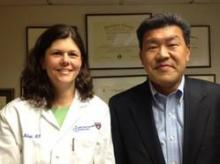The emergence of Accountable Care Organizations could have a significant impact on the day-to-day life of hospitalists, or then again not much at all.
It all depends on how far along hospital medicine groups are in developing systems of communication and improving transitions of care. Those groups that have invested the time and money in information technology systems, improving the discharge process, and building relationships with primary care physicians are likely to be ahead of the curve and ready to participate almost seamlessly in ACOs. The others will be playing catchup, experts agree.
Dr. Melissa Mattison, associate chief of the hospital medicine section at Beth Israel Deaconess Medical Center in Boston, currently treats patients from two different ACOs operating in the Boston area – the Beth Israel Deaconess Physician Organization and Atrius Health. She and her hospitalist colleagues were prepared for the introduction of the ACO model of care, which aims to better coordinate the management of patients by holding networks of providers financially accountable for the quality and cost of care across the inpatient and outpatient settings.
At Beth Israel, there is a robust electronic health record system that keeps primary care physicians up to date on their hospitalized patients so that communication occurs at key points of care. A postdischarge clinic provides timely follow-up care to patients who have difficulty accessing primary care services.
This proactive approach is a well-established strategy of Beth Israel’s hospital medicine program, Dr. Mattison noted. "This has been somewhat the mantra of hospital medicine: improved care for patients, improved transitions of care, and making sure we’re really creating a plan of care."
Not much has changed since the introduction of the ACO model in how she delivers care on a day-to-day basis. "Hospitalists are really trying day in and day out to do what’s right for the patient in front of them and to work with the system that they have," Dr. Mattison said.
ACOs have been a buzzword in health policy circles for about the last 5 years, and a few commercial health plans have experimented with the idea. But ACOs really got off the ground earlier this year when the Centers for Medicare and Medicaid Services (CMS) began testing the model among fee-for-service Medicare beneficiaries.
How this will impact hospitalists’ payments is still unclear. Several experts said that since hospitalist payment arrangements vary so widely already, the financial incentives associated with ACOs also are likely to be site specific.
Dr. Mattison said the ACO model provides an opportunity for hospitalists to continue the work they’ve already begun on transitions of care.
The financial incentives in the ACO environment call for keeping patients healthy and out of the hospital. For hospitalists, that means primarily preventing readmissions. That’s nothing new, said Dr. Joseph Li, chief of hospital medicine at Beth Israel Deaconess Medical Center and past president of the Society of Hospital Medicine.
"The things that hospitalists need to be thinking about should be things that we’ve really been talking about all along," he said.
But there will be some differences, too, Dr. Li said. It will likely be less important for hospitalists to focus on decreasing length of stay and doing discharges earlier in the day.
For instance, in the pre-ACO environment, a patient might be discharged to receive care at a rehabilitation facility for a few days before going home. But in the new ACO environment, the hospitalist may keep the same patient in the hospital another day and avoid the additional expense of the rehab stay.
"I think that we’re going to see that hospitalists are going to be thinking about that, and appropriately so," Dr. Li said. "That’s where it’s important for the patient, the doctor, and the hospital to be on the same page."
Dr. Li estimates that about 70% of the patients he sees are part of an ACO arrangement. But all patients that come through his hospital get the same care, he said, effectively raising the quality for everyone.
"We’re not picking and choosing which patients we don’t want readmitted," he said. "The real focus is that we want everybody not to be readmitted."
At the OSF Healthcare System – an integrated health system in Central Illinois and 1 of the 32 Pioneer ACOs selected by CMS for testing of the care model – they have the same philosophy about changing the way they provide care regardless of which patients are in an ACO.

